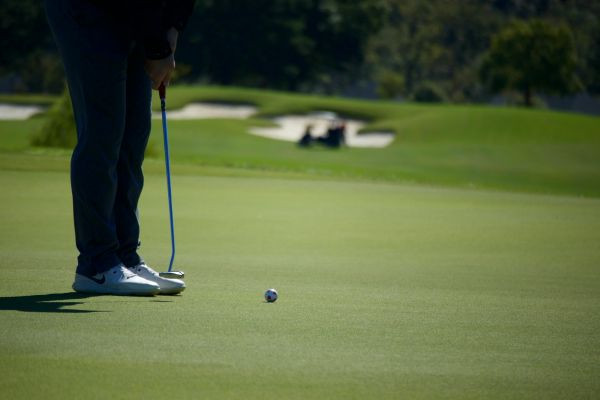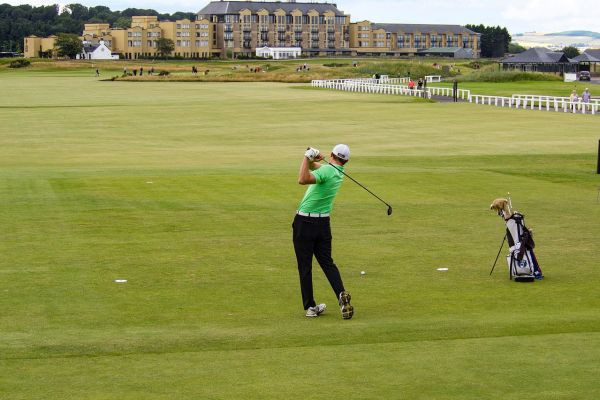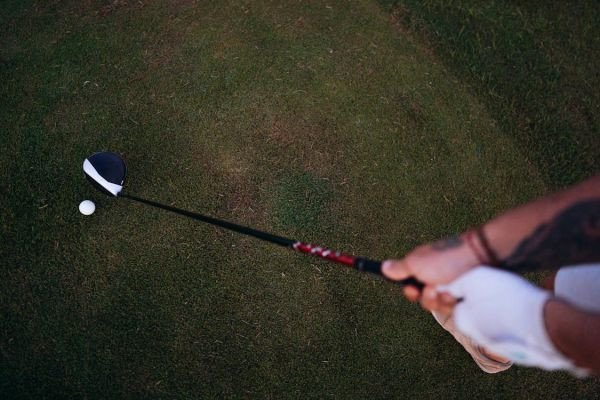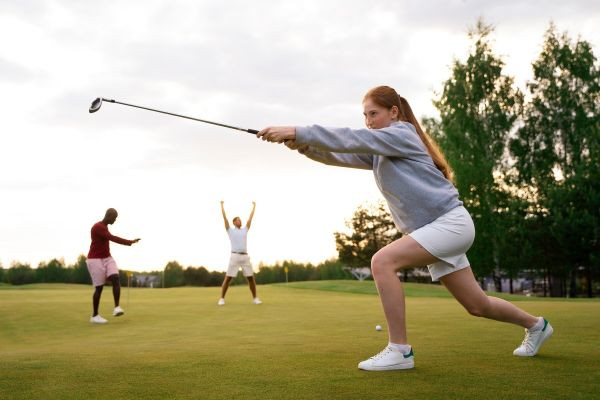The Essential Steps to Effectively Cover the Golf Ball
Golf is a game of precision and technique, and one of the most crucial yet often misunderstood concepts in golf is 'covering the golf ball.' This guide dives deep into what it means to effectively cov..

Golf is a game of precision and technique, and one of the most crucial yet often misunderstood concepts in golf is 'covering the golf ball.' This guide dives deep into what it means to effectively cover the golf ball, the techniques involved, and how you can incorporate this skill into your golf game to see remarkable improvements.
What Does "Covering the Golf Ball" Mean?
The term 'covering the golf ball' resonates frequently in the lexicon of golf enthusiasts and professionals alike. But what does this term, often spoken in hushed tones of reverence or earnest discussion, actually signify? In the simplest terms, it refers to a specialized swing technique. This technique is not about physical coverage of the ball but a strategic approach to the golf swing.
It involves maintaining a specific, disciplined posture while simultaneously managing the angle of the clubface throughout the swing. This method is instrumental in achieving better ball compression - a key factor for a golfer's successful play. Moreover, it allows for more controlled and precise shots, an essential aspect for any golfer aspiring to refine their game.
Covering the golf ball is more than just a physical maneuver; it's an embodiment of skill, precision, and careful control. It's the art of aligning body mechanics and equipment in a harmonious dance, culminating in a swing that is as effective as it is graceful.
Why Is It Important?
The importance of mastering the technique of covering the golf ball cannot be overstated for any golfer intent on enhancing their game. This technique is a cornerstone for achieving consistency in your shots. When executed correctly, it ensures that each swing you take is not left to chance but is a result of deliberate, practiced movements. This consistency is what separates seasoned golfers from novices.
Additionally, the technique plays a pivotal role in generating powerful shots. By mastering the art of covering the golf ball, golfers can ensure that they are making the most efficient use of their energy and strength in each swing. This efficiency translates into shots that travel longer distances, an undoubted advantage on the course.
Accuracy is another facet improved by this technique. The controlled and precise nature of a covered golf ball swing means that golfers can direct their shots with greater precision. This accuracy is crucial, whether you're aiming for the fairway on a long drive or targeting the green on an approach.
The Key Moves to Cover the Golf Ball

Source:https://www.pexels.com/photo/close-up-photo-of-golf-ball-2828723/
To master the art of covering the golf ball, two fundamental moves must be perfected: chest and body movement, and delofting your clubface. Each of these plays a pivotal role in the execution of a golf swing that not only feels right but yields impressive results on the course.
Move #1: Chest and Body Movement
The journey to an effective golf swing begins with the first critical move: the downward motion of your chest and body towards the ball during the downswing. This move is more than just a physical action; it's the foundation of maintaining a dynamic and balanced posture throughout the swing. By allowing your chest and body to move downwards, you are effectively aligning your swing's center of gravity. This alignment is key in ensuring that the clubhead travels along the correct path towards the ball, enhancing the likelihood of a clean, solid contact.
This downward movement is also instrumental in stabilizing the lower body, providing a solid base from which to power the swing. It engages the core muscles, creating a coil of energy that, when released, adds significant power to the swing. The synchronization of this movement with the arms and club creates a harmonious and efficient swing that maximizes power without sacrificing control.
The Incorrect Approach
A common pitfall for many golfers is the premature straightening or 'standing up' of the body during the downswing. This error, often a result of an eagerness to 'hit' the ball, disrupts the swing's natural arc. When a golfer stands up too early, it typically leads to the dreaded 'flipping' of the club at impact - a compensation for the loss of the proper swing path. When you swing the golf club it's important to avoid flipping your wrists because it can negatively impact your power and control. Flipping leads to shots that lack accuracy causing them to deviate from the intended path and fall short of the target.
Move #2: Delofting Your Clubface
Another important aspect of hitting the golf ball effectively is to deloft your clubface at impact. This doesn't mean covering the ball with the clubface, but rather creating a sensation that you are doing so. Rather creating a sensation that you are doing so. To achieve this you need to have forward shaft lean, at impact which means your hands should be ahead of the ball and the club shaft leaning towards the target. This position naturally decreases the loft angle of the clubface when it makes contact with the ball.
Having forward shaft lean is crucial for these reasons. It increases control over trajectory and spin by reducing loft on the clubface. It also helps create a contact with compression on the ball resulting in shots that are not only accurate but also travel longer distances. Mastering this technique can greatly enhance a golfer's ability to make shots.
The Pro's Approach
Professional golfers on the PGA Tour demonstrate their expertise in reducing the loft of the clubface. They typically decrease the club's loft by 30% depending on the club they are using. For example experienced players effectively use a pitching wedge, which usually has a 45 degree loft. This adjustment in the angle of loft showcases their skill in controlling both flight and spin of the ball.
This professional approach to reducing loft significantly contributes to the distance and accuracy observed in shots by golfers. By mastering this technique they achieve a level of precision and consistency that many amateur golfers aspire to attain. This clearly illustrates how aspects of technique, like shaft lean and management of clubface angle can greatly influence the outcome of the game.
Looking Deeper into the Technique
To truly excel in covering the golf ball it is essential to delve into understanding the elements underlying a golf swing.
Two important factors that require attention are the role of shaft lean and the impact of the clubface angle when striking the ball. Mastering these elements is crucial, for any golfer looking to enhance their skills and performance.
The Role of Shaft Lean
Shaft lean, a term commonly used in golf instruction, refers to the angle created by the golf club shaft in relation to the ground at impact. This angle plays a role in determining the quality of the shot. Having the shaft lean, where the top of the shaft leans towards the target during impact is essential for covering the ball.
The importance of forward shaft lies in its ability to decrease clubface loft. By leaning the shaft it reduces how much loft is on the clubface at impact resulting in a flatter ball trajectory. This flatter trajectory is often desired for controlled and longer shots. Forward shaft lean also helps improve contact, with the ball allowing golfers to compress it against the clubface effectively.
Achieving distance and ensuring energy transfer, from the club to the ball relies heavily on compression.
Minimizing mishits is also influenced by mastering shaft lean. It helps reduce the chances of hitting the ball too fat, which are common errors that can lead to inconsistent play. For golfers aiming to improve their shots and achieve that contact, understanding and practicing proper shaft lean is crucial.
The Impact of Clubface Angle
The angle of the clubface at impact is another factor in a golf swing. This angle plays a role in controlling the trajectory and spin of the ball. When the clubface makes contact with the ball its angle affects how it flies and how backspin it generates.
Making adjustments to the clubface angle during impact can have an impact on the shot's outcome. For example an open clubface, where it is angled away from the golfer tends to produce shots with more spin, which can be advantageous for approach shots towards the green.
On the other hand if you close the clubface and angle it towards yourself as a golfer you will typically achieve longer shots, with less spin. This is especially useful for drives or shots against the wind.
Mastering the manipulation of the clubface angle requires skill and dedicated practice. It's not about positioning your hands and wrists, it also involves timing your swing. To ensure that the clubface is aligned properly at impact golfers must synchronize their body movements with their swing mechanics.
How to Practice These Techniques
Now let's talk about how to put these techniques into practice. Transitioning from understanding the theory to applying it on the golf course is a step towards improving your game. Incorporating these techniques into your practice calls for an approach that focuses on specific drills and exercises designed to ingrain these skills into muscle memory.
To start, begin your practice session with drills that emphasize maintaining posture throughout the swing. One effective drill is called the 'Mirror Drill.' Stand in front of a mirror, in your golf stance. Observe your body movement as you practice swinging. Pay attention to keeping your chest and head level throughout each swing.
This exercise is designed to help you maintain the posture and alignment which is essential for effectively hitting the golf ball.
Next incorporate drills that focus on having a lean of the club shaft. One beneficial drill for this is called the 'Alignment Stick Drill.' To do this drill place an alignment stick in the ground at an angle that matches the desired lean of the club shaft at impact. Then practice your swing while mimicking and matching the angle of the stick with your club at the moment of contact. This visual aid will assist you in understanding and achieving the correct shaft lean, which's crucial, for reducing loft on your clubface.
It's crucial to begin these practice exercises at a pace emphasizing the quality of your movements rather than focusing on speed or power in your swing. Gradually as you become more comfortable and consistent with these techniques, incorporate them into your swing.
Pitfalls to Avoid in Your Swing
While working on integrating these techniques into your swing it's important to be mindful of mistakes that can hinder your progress.
One frequent mistake among golfers is initiating the downswing by moving their hips towards the ball. This premature hip movement disrupts the swing path and Leads to inconsistency in shots. To correct this concentrate on starting the downswing with a movement of the chest and body as mentioned earlier. This will help keep your hips in the position throughout the entire swing.
A helpful exercise to address hip movement is known as the 'Chair Drill.' Place a chair directly behind you so that it lightly touches your backside when you're in your stance or starting position for the golf swing. As you execute your swing ensure that there is contact between your buttocks and the chair until impact occurs. This will prevent the thrusting of the hips forward.
It's important to pay attention to your posture while swinging in order to achieve results. Making changes to your stance or standing up during the swing can significantly impact the power and accuracy of your shots. To avoid this a useful drill called the 'Head Against the Wall Drill' can be practiced. Set yourself up for a swing with your head resting against a wall and throughout the swing maintain contact between your head and the wall. This drill promotes an angle and prevents the common mistake of losing proper posture.
Tips from the Pros
Advice from pro golfers can be incredibly valuable when it comes to improving your technique. Their extensive experience and expertise in the sport provide a wealth of knowledge that can help take your golf game to new heights. In this section we'll explore some tips from professionals that focus on refining aspects of your swing.
One area where professional advice can particularly make a difference is in tuning your downswing and follow through. These stages of the swing play a role in determining the trajectory, speed and accuracy of each shot.
The first thing you need to focus on is making your movements smooth and consistent. It's important to have a fluid downswing and follow through, in order to maintain control and balance throughout your swing. Instead of relying on arm strength try to coordinate your body's movements rhythmically.
Pay attention to the feedback you get from each shot. Every shot, whether it's successful or not, provides information. For example if your shots consistently veer to the right it could mean that there's an issue with how your clubface aligns at impact. Similarly if you're not getting distance with your shots it might be a sign that you need to work on optimizing your swing speed or the point of contact with the ball. Being able to interpret and respond to this feedback is a skill that professional golfers excel at and is crucial for improvement.
Another useful tip is to focus on the tempo of your swing. Many amateur golfers mistakenly believe that speed equals power, which often results in rushed and uncontrolled swings. Professionals understand that a timed and rhythmic swing generates effective power and control.
To improve the quality of your shots, in golf it's important to maintain a tempo from the beginning of your backswing all the way to the follow through.
Wrapping It Up
In conclusion mastering the technique of covering the golf ball goes beyond being a skill. It plays a role in enhancing your golf game. By understanding and implementing movements such as maintaining posture, achieving forward shaft lean and adjusting the clubface angle you lay the groundwork for more powerful, accurate and consistent play.
Frequently Asked Questions (FAQs)
What is the main benefit of covering the golf ball?
One significant advantage of covering the golf ball is that it greatly enhances ball compression. This factor is essential for achieving distance in your shots. It also improves shot accuracy by allowing for precision and control on the course. Furthermore, consistently covering the golf ball results in a predictable ball flight, which is vital for improving your overall golf performance.
How does chest and body movement affect my swing?
Maintaining posture throughout your swing relies heavily on chest and body movement. This is crucial inorder to generate power and control when taking a shot. This technique is important for positioning your body which helps ensure that your swing follows the correct path for maximum efficiency and accuracy. It also helps prevent swing mistakes like slicing or hooking the ball resulting in shots that're more consistent and straight.
What does forward shaft lean achieve?
Having a shaft lean of the club at the moment of impact is crucial because it reduces the loft of the clubface. This allows for more controlled shots with a desirable trajectory. It also ensures contact with the ball maximizing energy transfer and increasing shot distance. Moreover having a lean of the club contributes to shot direction control minimizing the chance of wayward shots.
How does clubface angle influence my shots?
The angle at which you hold your clubface at impact greatly influences how the ball travels and spins. If you have an open clubface your shots will tend to be higher with more spin. Conversely if you have a closed clubface you can expect shots that travel longer distances with less spin. Mastering control over your clubface angle empowers golfers to adapt their shots to situations, on the course enabling them to handle challenges effectively and achieve optimal shot outcomes.
What are common mistakes to avoid while trying to cover the golf ball?
When trying to address the golf ball it's important to avoid some errors. One is moving your hips early, towards the ball as this can mess up your swing path. Another thing to watch out for is maintaining posture as this can affect the power and accuracy of your shot. It's also best to steer clear of flipping the club at impact which often happens when timing or posture is off. Doing so can result in unpredictable shots








































































